
The Phenomenon of Goosebumps
Goosebumps, scientifically referred to as piloerection, manifest when tiny muscles located at the base of hair follicles contract. This biological reaction causes the hair to stand upright, resulting in the distinct appearance of bumps on the skin. While on the surface, this might appear to be a trivial response, goosebumps offer intriguing insights into human evolutionary pathways and physiological processes.
The Biological Mechanism Behind Goosebumps
The genesis of goosebumps is primarily managed by the autonomic nervous system. More explicitly, it is governed by the sympathetic branch, which takes charge of the body’s fight-or-flight response. On stimulus, sensitive nerve endings provoke the contraction of the arrector pili muscles situated adjacent to each hair follicle. These contractions force the hair to stand erect, creating the recognizable bumps on the outer skin layer.
The autonomic nervous system operates automatically, and individuals do not consciously control these processes. This reflex mechanism ensures that the body can prepare rapidly for physical challenges or adapt swiftly to environmental changes. When the arrector pili muscles receive the signal to contract, they do so instantaneously, indicating the efficiency and rapid response capability of this system.
The Evolutionary Perspective
From an evolutionary lens, goosebumps originate from a vestigial reflex, indicating traits that served a role in our ancestors but may no longer be as vital today. In our animal progenitors, this response fulfilled two essential roles:
Insulation: During exposure to frigid conditions, standing hairs entrap a layer of air, creating an insulating barrier instrumental in maintaining body warmth. This mechanism proved more beneficial to our ancestors blessed with denser body hair compared to contemporary humans.
Intimidation: Erect hairs render an animal larger and more intimidating to potential predators or rivals, offering a means of defense or a display of dominance. This response was particularly crucial during encounters in which an animal had to assert superiority or avoid confrontation by appearing more formidable than it really was.
Modern humans, possessing relatively sparse body hair, find this reflex more obsolete. Yet, it persists as a fascinating remnant of our evolutionary journey, connecting us to the primal instincts of our forebears.
Common Triggers for Goosebumps
Multiple factors can instigate the development of goosebumps, and understanding these triggers provides insight into their functional role even today:
Temperature Changes: Abrupt exposure to cold or breezy conditions frequently incites this reflex. The predominant objective of the body is to conserve warmth by curtailing heat loss. As a survival strategy, this response ensures that the body can attempt to maintain its core temperature, reducing the rapidity with which it loses heat to the external environment.
Emotional Stimuli: Stressful or profoundly emotional situations can provoke goosebumps. Emotions envelop a wide array of experiences, and the thrill of engaging with certain musical compositions, observing a theatrical scene climax, or experiencing powerful emotions can prompt this reaction. This connection between emotions and physical reaction underscores the deep integration of psychological and physiological processes.
Fear or Surprise: Unanticipated events or startling stimuli trigger the body’s fight-or-flight response, resulting in goosebumps as part of this primal reaction. These involuntary reactions are remnants of when quick responses to danger or unexpected scenarios were essential for survival.
The Significance of Goosebumps in Scientific Research
Despite the apparent simplicity of goosebumps, these small, transient reactions reveal volumes about human physiology. Researchers study goosebumps to comprehend better the intersection of evolutionary biology and modern human physiology. Investigating this phenomenon allows scientists to delve into autonomic nervous responses, offering insights into how the body manages involuntary reactions and adapts to external stimuli.
Additionally, the study of piloerection extends into evaluating emotional and psychological triggers. By investigating what psychological states produce goosebumps, scientists can explore deeper connections between the mind and body, offering potential insights into how emotions manifest physically and the links between psychological stressors and physical responses. Such research could have applications in understanding conditions where sensation, emotion, and muscle responses are intertwined.
Conclusion
Goosebumps, while seemingly minor and transient physical reactions, offer a window into the intricate dynamics of the human body, connecting us with our extensive evolutionary background. Although modern human lifestyles render the practical functionality of goosebumps less significant, their persistence serves as a captivating reminder of our biological ancestry. These reflexive responses still provide a linkage to understanding broader physiological processes and the magnitude of evolutionary influences shaping the way our bodies respond to varying stimuli.
For those interested in delving deeper into the physiological responses seen in humans, scientific research databases like NCBI serve as invaluable resources, as do educational platforms such as Khan Academy. These platforms provide comprehensive information on autonomic nervous responses, evolutionary biology, and the complex interplay between cognitive and physical reactions.
